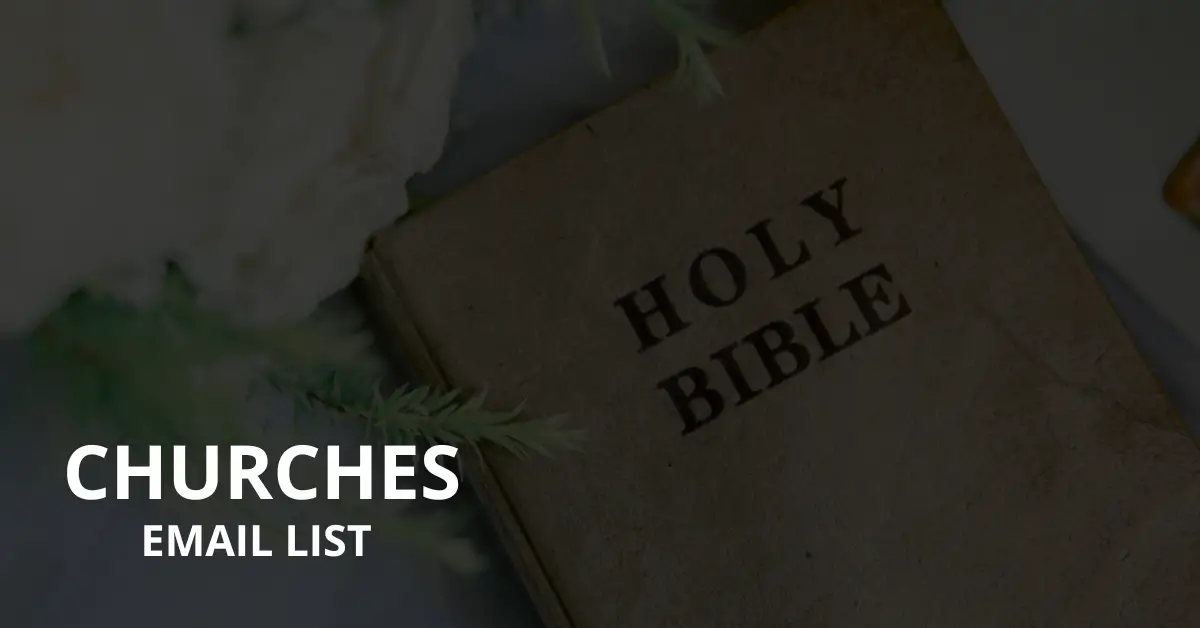In today’s digital age, email marketing has become a crucial tool for organizations of all types, including churches and religious institutions. A Churches Email List allows churches, ministries, and faith-based organizations to maintain direct communication with their congregations, donors, volunteers, and the wider community. Whether you’re spreading a message of faith, promoting events, or seeking donations, having a well-curated email list is invaluable. This article explores the significance of a churches email list, how it benefits your organization, and how to build and use it effectively.
What is a Churches Email List?
A Churches Email List is a collection of email addresses belonging to church members, faith leaders, donors, volunteers, and others interested in receiving updates, spiritual content, event announcements, or ministry-related information. This list can also include contacts from other churches, religious organizations, community leaders, and even local businesses that support faith-based initiatives. With a well-segmented email list, churches can reach their target audience directly, building a stronger sense of community and engagement.
Key Benefits of Using a Churches Email List
- Direct Communication with Congregation and Community
An email list allows churches to communicate directly with their congregation and wider community. Whether you’re sharing spiritual messages, promoting a special event, or sending updates about your services, email provides a reliable way to reach your audience instantly. This is especially important for time-sensitive communications like service changes or emergency updates. - Strengthening Relationships
Email lists help build and strengthen relationships between churches and their members. By providing regular, personalized updates, spiritual encouragement, or ministry resources, churches can stay connected with their congregants throughout the week. This consistent communication fosters a sense of belonging and engagement, which is vital for maintaining an active and supportive church community. - Promoting Events and Initiatives
Churches often host a variety of events, including worship services, community outreach programs, fundraising activities, and special holiday celebrations. A churches email list allows you to promote these events to your congregation and the broader community. Sending targeted event reminders, registration forms, and follow-up emails can increase attendance and participation. - Encouraging Donations and Fundraising
Email marketing is a powerful tool for fundraising. Churches can use their email lists to appeal to members and donors for financial support. With clear, well-crafted messages, you can highlight your church’s financial needs and the impact of donations. Automated email campaigns can also be set up for recurring giving, end-of-year appeals, and special donation drives. - Building a Strong Volunteer Base
Volunteers are often the backbone of church operations. An email list allows you to reach out to potential volunteers, informing them about service opportunities within your ministry. Regular communication can keep volunteers engaged, motivated, and informed about upcoming initiatives. - Cost-Effective Outreach
Compared to traditional forms of outreach such as direct mail or print advertising, email marketing is significantly more cost-effective. Churches can send personalized messages to large groups without the cost of printing or postage. Email marketing tools also provide analytics, enabling you to track engagement and make data-driven decisions about your communication strategies.
How to Build a Churches Email List
Creating a high-quality email list for your church or ministry requires time and effort, but the rewards are well worth it. Here are several strategies to build your churches email list:
- Promote Sign-Ups at Church Services
One of the easiest ways to grow your churches email list is by encouraging members to sign up during services. Place sign-up sheets at the entrance, offer digital sign-ups via a QR code, or integrate email collection into your church’s mobile app. Make sure to explain the benefits of joining the list, such as receiving weekly updates, spiritual messages, or event reminders. - Use Your Church Website
Your church’s website is a powerful tool for collecting email addresses. Embed sign-up forms on your homepage, blog, or event pages. Make the forms easy to find and simple to fill out, asking only for necessary information like name and email address. Offering incentives like downloadable Bible studies, devotionals, or event guides in exchange for email sign-ups can also encourage more people to subscribe. - Leverage Social Media Platforms
Many churches use social media to engage with their congregation and community. Use your social media channels to promote your email list by offering exclusive content, event announcements, or spiritual encouragement to email subscribers. Post links to your email sign-up forms regularly, and consider running social media campaigns that encourage followers to join your email list. - Offer Lead Magnets
A lead magnet is something valuable that you offer in exchange for someone’s email address. For churches, lead magnets can include free spiritual resources like devotionals, prayer guides, Bible study materials, or event registration. Make sure the lead magnet is something that aligns with the needs and interests of your community. - Engage During Church Events
Church events, whether online or in-person, offer a prime opportunity to gather email addresses. Whether it’s a special worship service, holiday celebration, or community outreach event, set up a system where attendees can sign up for email updates. For virtual events, create an email capture form that attendees must fill out to register. - Collaborate with Other Faith-Based Organizations
Partnering with other churches or faith-based organizations can help grow your email list. Cross-promote each other’s events, webinars, or resources through email campaigns and share contacts (with permission) to expand your reach within the faith community.
Best Practices for Utilizing a Churches Email List
Building a churches email list is just the first step; using it effectively is equally important. Below are some best practices for ensuring your email campaigns are successful and well-received.
- Segment Your List for Better Targeting
Segmenting your email list allows you to send more personalized and relevant content. For instance, you can segment based on members, volunteers, new visitors, or donors. Tailor your messages to each group’s specific needs, whether it’s spiritual encouragement, service reminders, or fundraising appeals. - Craft Engaging and Uplifting Subject Lines
The subject line is often the first thing recipients see, and it plays a critical role in whether or not they open the email. Create subject lines that are engaging, uplifting, and reflect the content inside. Phrases like “A Message of Hope,” “Join Us for Sunday Worship,” or “Special Prayer Request” can catch the recipient’s attention. - Personalize Your Emails
Personalization is key to building strong connections. Address recipients by their first names, and where possible, tailor the content to their individual preferences. For example, someone who volunteers frequently might appreciate updates on volunteer opportunities, while donors might be interested in how their contributions are being used. - Include Clear and Simple CTAs
A call to action (CTA) guides your audience toward the next step, whether it’s signing up for an event, making a donation, or simply replying with a prayer request. Make sure your CTA is clear, concise, and easy to follow. Avoid overwhelming your audience with multiple CTAs in a single email. - Maintain a Consistent Sending Schedule
Consistency is key when it comes to email communication. Set a regular schedule for sending out emails, whether it’s a weekly newsletter, monthly updates, or event reminders. Stick to the schedule, as your audience will come to expect and rely on your communications. - Monitor and Optimize Performance
Use email marketing tools to track the performance of your campaigns. Pay attention to open rates, click-through rates, and engagement levels. A/B testing different elements such as subject lines, content, and send times can help you understand what resonates most with your audience and optimize future campaigns.
Conclusion
A Churches Email List is a valuable tool for maintaining strong communication with your congregation, donors, and community. By strategically building and utilizing an email list, churches can deepen relationships, increase engagement, promote events, and support fundraising efforts. Email marketing offers an affordable and effective way to ensure your church’s message reaches the right audience at the right time, helping you foster a vibrant and connected faith community.






